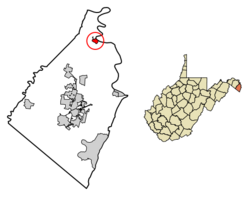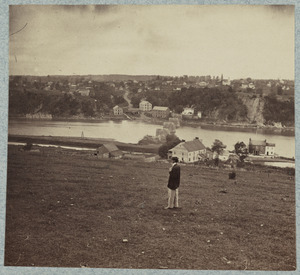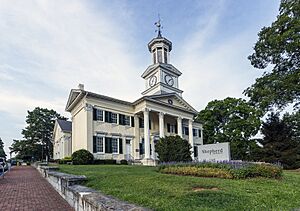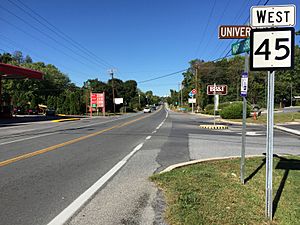Shepherdstown, West Virginia facts for kids
Quick facts for kids
Shepherdstown, West Virginia
|
|
|---|---|

German Street, Shepherdstown Historic District
|
|

Location of Shepherdstown in Jefferson County, West Virginia.
|
|
| Country | United States |
| State | West Virginia |
| County | Jefferson |
| Settlement | 1730 |
| Established | December 23, 1762 |
| Area | |
| • Total | 0.401 sq mi (1.039 km2) |
| • Land | 0.401 sq mi (1.039 km2) |
| • Water | 0.000 sq mi (0.000 km2) |
| Elevation | 400 ft (100 m) |
| Population
(2020)
|
|
| • Total | 1,531 |
| • Estimate
(2021)
|
1,494 |
| • Density | 4,765.59/sq mi (1,838.73/km2) |
| Time zone | UTC-5 (EST) |
| • Summer (DST) | UTC-4 (EDT) |
| ZIP code |
25443
|
| Area code | 304 |
| FIPS code | 54-73468 |
| GNIS feature ID | 2391411 |
Shepherdstown is a small town in Jefferson County, West Virginia, USA. It's located in the beautiful Shenandoah Valley right by the Potomac River. This town is special because it's home to Shepherd University. In 2020, about 1,531 people lived here. Shepherdstown was founded in 1762, making it one of the two oldest towns in West Virginia, along with Romney.
Contents
History of Shepherdstown
Early Beginnings in the 1700s
Shepherdstown was officially started on December 23, 1762. It was first called Mecklenburg. This happened thanks to laws passed by the Virginia House of Burgesses. Along with Romney, it became one of the two oldest towns in West Virginia.
British settlers started moving into the northern Shenandoah Valley in the early 1700s. Many crossed the Potomac River at a place called Pack Horse Ford. In 1734, Thomas Shepherd (1705–1776) received a large piece of land. He chose 50 acres from it to create a town. He named it Mecklenburg and asked the Virginia General Assembly for official permission, which he got in 1762.
Thomas Shepherd was in charge of the town at first. He owned the land and managed its government. The town had many natural springs that fed into a stream called Town Run. This stream never flooded or dried up. It was perfect for people who worked as millers, tanners, potters, and blacksmiths. By 1775, about 1,000 people lived in Mecklenburg.
In 1775, General George Washington asked for volunteer soldiers from Virginia. Captain Hugh Stephenson gathered his company of riflemen here. They left from "Morgan's Spring" on July 16, 1775. This group made a famous "Beeline March to Cambridge". They traveled 600 miles in just 24 days! Many Revolutionary War veterans are buried nearby.
On December 3, 1787, James Rumsey showed off his new invention: the steamboat. He tested it successfully in the Potomac River. The first newspaper in what is now West Virginia, The Potomac Guardian and Berkley Advertiser, was printed here in the 1790s. The first book, The Christian Panoply, was also published here. You can find a copy of this book at the Shepherdstown Public Library. Robert Lucas, who later became governor of Ohio, was born in Shepherdstown in 1781.
In 1794, the town received a new charter from Virginia. This allowed the town to govern itself. In 1798, the town's borders grew, and its name changed to Shepherd's Town. After the American Civil War, the name became officially shortened to Shepherdstown. The local clay soil was great for making bricks. Many brick homes and buildings were built here.
Shepherdstown in the 1800s

The Chesapeake and Ohio Canal (C&O Canal) reached Shepherdstown in the early 1830s. This canal ran along the Maryland side of the Potomac River. Lock no. 38, called "Shepherdstown River Lock," was built across from the town. This special lock allowed canal boats to move between the canal and the river. This helped industries in Shepherdstown get supplies like cement and coal. It also helped them ship out flour and grains. Shepherdstown is the only town in West Virginia with a canal lock named after it.
Two free schools were built in the town in 1848. One of them still stands today. When West Virginia became a state in 1863, these became the oldest free schoolhouses in the state.
Before the Civil War, a local military group called the Hamtramck Guard helped stop John Brown's raid at the Harpers Ferry Armory in 1859. When the Civil War began, this group joined the Confederate army. They became part of the famous "Stonewall Brigade."
After the Battle of Antietam in Maryland on September 17, 1862, General Robert E. Lee's soldiers crossed the Potomac River here. The town was suddenly filled with 5,000 to 8,000 wounded soldiers from the battle. Every house, building, and street became a place for the injured. The Battle of Shepherdstown happened on September 20, 1862, during Lee's retreat. More than 100 Confederate soldiers died here. They are buried in Elmwood Cemetery, which holds the graves of 285 Confederate veterans.
From 1865 to 1871, Shepherdstown was the county seat for Jefferson County. This was because the courthouse in Charles Town was damaged during the war. The Town Hall building in Shepherdstown served as the courthouse.
In 1872, the Town Hall Building became a "Classical and Scientific Institute." This building was then leased to the state, and Shepherd College was created. In 2004, Shepherd College became Shepherd University. The university now has two campuses that take up a big part of the town.
Shepherdstown: 1900s to Today
The Shepherdstown Historic District was created in 1973. It was added to the National Register of Historic Places. This means many old buildings in the town are protected. In 1987, the historic district was expanded to include the whole town.
On January 3, 2000, Shepherdstown was the location for important peace talks. Leaders from Israel and Syria met here to discuss peace.
In 2012, the town celebrated its 250th birthday! Shepherdstown is known for its history, local art, and the university. It's also sometimes called the "most haunted town in America." On June 12, 2016, a TV show called Ghosts of Shepherdstown premiered. It explored the town's ghostly legends.
Geography of Shepherdstown
Shepherdstown is located in the upper Shenandoah Valley. It sits right along the Potomac River in the eastern part of West Virginia. To the northeast, it shares a border with Maryland.
The town covers about 0.37 square miles (1.039 square kilometers) of land. There is no water area within the town limits.
The ground in Shepherdstown often has rocks from the Cambrian period. These rocks are called limestone and dolomite. They form cliffs between the town and the Potomac River.
Population and People
| Historical population | |||
|---|---|---|---|
| Census | Pop. | %± | |
| 1850 | 1,561 | — | |
| 1860 | 1,219 | −21.9% | |
| 1870 | 1,389 | 13.9% | |
| 1880 | 1,533 | 10.4% | |
| 1890 | 1,515 | −1.2% | |
| 1900 | 1,184 | −21.8% | |
| 1910 | 1,070 | −9.6% | |
| 1920 | 1,063 | −0.7% | |
| 1930 | 888 | −16.5% | |
| 1940 | 945 | 6.4% | |
| 1950 | 1,173 | 24.1% | |
| 1960 | 1,328 | 13.2% | |
| 1970 | 1,688 | 27.1% | |
| 1980 | 1,791 | 6.1% | |
| 1990 | 1,287 | −28.1% | |
| 2000 | 803 | −37.6% | |
| 2010 | 1,734 | 115.9% | |
| 2020 | 1,531 | −11.7% | |
| 2021 (est.) | 1,494 | −13.8% | |
| U.S. Decennial Census 2020 Census |
|||
As of 2010, there were 1,734 people living in Shepherdstown. The town had 518 households. About 85.5% of the people were White, and 9.5% were African American. Other races made up smaller parts of the population.
The average age in Shepherdstown was 21.9 years. Many residents (55.7%) were between 18 and 24 years old. This is because of Shepherd University being in town.
Culture and Fun Things to Do
Many of the old buildings on German Street are now shops and cafes. Shepherdstown has a lively arts scene. Many local art and theater groups are connected to Shepherd University. The town also has several restaurants and places to enjoy music. Monthly contra dances are held, sponsored by Shepherdstown Music and Dance.
Shepherdstown is also home to West Virginia's first cohousing community. It's called Shepherd Village. This community was started in 2013 and has 30 member households.
Historic Places to Visit
| Site | Year Built | Address | Listed |
|---|---|---|---|
| Boidstones Place (Greenbrakes Farm) | Shepherd Grade | 1999 | |
| Cold Spring | 1793 | CR 17 | 1973 |
| Elmwood | 1797 | CR 17 | 1973 |
| Falling Spring-Morgan's Grove | WV 480 | 1989 | |
| Fruit Hill (Robinson-Andrews-Hoxton House) | Shepherd Grade | 1988 | |
| Captain William Lucas and Robert Lucas House (Linden Spring) | 1793 | CR 31 | 1982 |
| James Marshall House (Marshall Hall) | Shepherd Grade | 1988 | |
| Morgan's Grove | WV 480, WV 230, Morgan's Grove Road | 1999 | |
| Morgan-Bedinger-Dandridge House (Rosebrake) | WV 480 | 1983 | |
| Rockland | 1897 | WV 480 | 1990 |
| Rose Hill Farm (James-Marshall-Snyder Farm) | Off WV 480 | 1990 | |
| Rumsey Hall (Entler Hotel) | late 18th century | German & Princess Streets | 1973 |
| Shepherd's Mill (Thomas Shepherd's Grist Mill) | High Street | 1971 | |
| Van Swearingen-Shepherd House (Bellevue) | Shepherd Grade | 1983 |
Getting Around Shepherdstown
Three main roads serve Shepherdstown. West Virginia Route 45 goes west from Shepherdstown to Martinsburg. It also connects to Interstate 81. West Virginia Route 230 goes south to U.S. Route 340 near Harpers Ferry. Finally, West Virginia Route 480 goes east across the Potomac River into Maryland. It continues as Maryland Route 34 towards Sharpsburg. To the west, WV 480 connects to West Virginia Route 9.
Famous People from Shepherdstown
- John James Abert (1788–1863), a topographer and founder of the National Institute of Science.
- Tyson Bagent (born 2000), an NFL quarterback who played college football at Shepherd University.
- Danielle Corsetto (born 1981), an artist and author known for her webcomic Girls With Slingshots.
- Danske Dandridge (1854–1914), a poet, writer, and historian.
- Violet Dandridge (1878–1956), a scientific illustrator, painter, naturalist, and supporter of women's right to vote.
- Frances Meehan Latterell (1920–2008), a plant pathologist who retired in Shepherdstown.
- Edwin Gray Lee (1837–1870), a Confederate general, lawyer, and relative of Robert E. Lee.
- James Rumsey (1743–1792), the inventor of an early steam-powered ship.
- Jim Tennant (1907–1967), a former MLB pitcher.
- Peter Tompkins (1919–2007), a journalist and spy during World War II.
See also
 In Spanish: Shepherdstown (Virginia Occidental) para niños
In Spanish: Shepherdstown (Virginia Occidental) para niños



